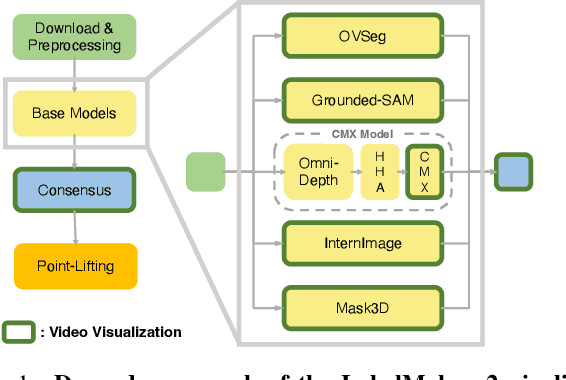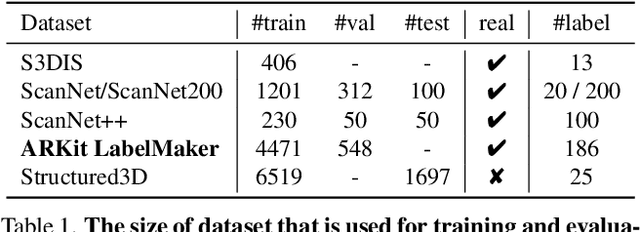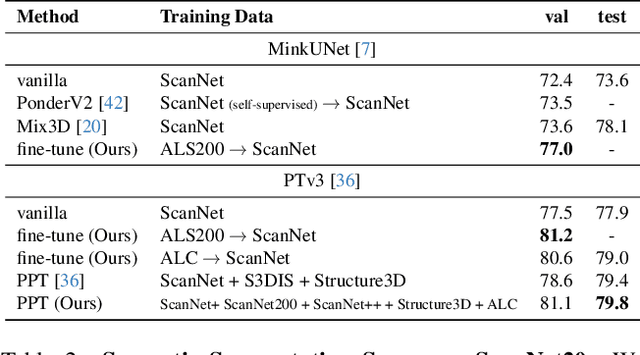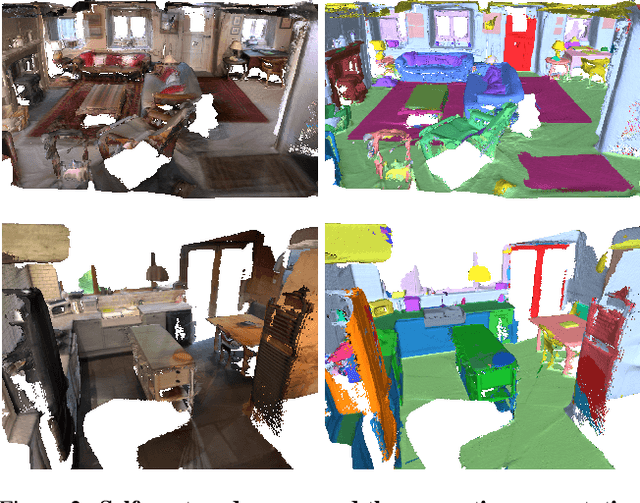Hermann Blum
ActLoc: Learning to Localize on the Move via Active Viewpoint Selection
Aug 28, 2025Abstract:Reliable localization is critical for robot navigation, yet most existing systems implicitly assume that all viewing directions at a location are equally informative. In practice, localization becomes unreliable when the robot observes unmapped, ambiguous, or uninformative regions. To address this, we present ActLoc, an active viewpoint-aware planning framework for enhancing localization accuracy for general robot navigation tasks. At its core, ActLoc employs a largescale trained attention-based model for viewpoint selection. The model encodes a metric map and the camera poses used during map construction, and predicts localization accuracy across yaw and pitch directions at arbitrary 3D locations. These per-point accuracy distributions are incorporated into a path planner, enabling the robot to actively select camera orientations that maximize localization robustness while respecting task and motion constraints. ActLoc achieves stateof-the-art results on single-viewpoint selection and generalizes effectively to fulltrajectory planning. Its modular design makes it readily applicable to diverse robot navigation and inspection tasks.
Spot-On: A Mixed Reality Interface for Multi-Robot Cooperation
May 28, 2025



Abstract:Recent progress in mixed reality (MR) and robotics is enabling increasingly sophisticated forms of human-robot collaboration. Building on these developments, we introduce a novel MR framework that allows multiple quadruped robots to operate in semantically diverse environments via a MR interface. Our system supports collaborative tasks involving drawers, swing doors, and higher-level infrastructure such as light switches. A comprehensive user study verifies both the design and usability of our app, with participants giving a "good" or "very good" rating in almost all cases. Overall, our approach provides an effective and intuitive framework for MR-based multi-robot collaboration in complex, real-world scenarios.
Loop Closure from Two Views: Revisiting PGO for Scalable Trajectory Estimation through Monocular Priors
Mar 20, 2025Abstract:(Visual) Simultaneous Localization and Mapping (SLAM) remains a fundamental challenge in enabling autonomous systems to navigate and understand large-scale environments. Traditional SLAM approaches struggle to balance efficiency and accuracy, particularly in large-scale settings where extensive computational resources are required for scene reconstruction and Bundle Adjustment (BA). However, this scene reconstruction, in the form of sparse pointclouds of visual landmarks, is often only used within the SLAM system because navigation and planning methods require different map representations. In this work, we therefore investigate a more scalable Visual SLAM (VSLAM) approach without reconstruction, mainly based on approaches for two-view loop closures. By restricting the map to a sparse keyframed pose graph without dense geometry representations, our '2GO' system achieves efficient optimization with competitive absolute trajectory accuracy. In particular, we find that recent advancements in image matching and monocular depth priors enable very accurate trajectory optimization from two-view edges. We conduct extensive experiments on diverse datasets, including large-scale scenarios, and provide a detailed analysis of the trade-offs between runtime, accuracy, and map size. Our results demonstrate that this streamlined approach supports real-time performance, scales well in map size and trajectory duration, and effectively broadens the capabilities of VSLAM for long-duration deployments to large environments.
FunGraph: Functionality Aware 3D Scene Graphs for Language-Prompted Scene Interaction
Mar 10, 2025Abstract:The concept of 3D scene graphs is increasingly recognized as a powerful semantic and hierarchical representation of the environment. Current approaches often address this at a coarse, object-level resolution. In contrast, our goal is to develop a representation that enables robots to directly interact with their environment by identifying both the location of functional interactive elements and how these can be used. To achieve this, we focus on detecting and storing objects at a finer resolution, focusing on affordance-relevant parts. The primary challenge lies in the scarcity of data that extends beyond instance-level detection and the inherent difficulty of capturing detailed object features using robotic sensors. We leverage currently available 3D resources to generate 2D data and train a detector, which is then used to augment the standard 3D scene graph generation pipeline. Through our experiments, we demonstrate that our approach achieves functional element segmentation comparable to state-of-the-art 3D models and that our augmentation enables task-driven affordance grounding with higher accuracy than the current solutions.
FrontierNet: Learning Visual Cues to Explore
Jan 08, 2025



Abstract:Exploration of unknown environments is crucial for autonomous robots; it allows them to actively reason and decide on what new data to acquire for tasks such as mapping, object discovery, and environmental assessment. Existing methods, such as frontier-based methods, rely heavily on 3D map operations, which are limited by map quality and often overlook valuable context from visual cues. This work aims at leveraging 2D visual cues for efficient autonomous exploration, addressing the limitations of extracting goal poses from a 3D map. We propose a image-only frontier-based exploration system, with FrontierNet as a core component developed in this work. FrontierNet is a learning-based model that (i) detects frontiers, and (ii) predicts their information gain, from posed RGB images enhanced by monocular depth priors. Our approach provides an alternative to existing 3D-dependent exploration systems, achieving a 16% improvement in early-stage exploration efficiency, as validated through extensive simulations and real-world experiments.
Lost & Found: Updating Dynamic 3D Scene Graphs from Egocentric Observations
Nov 28, 2024



Abstract:Recent approaches have successfully focused on the segmentation of static reconstructions, thereby equipping downstream applications with semantic 3D understanding. However, the world in which we live is dynamic, characterized by numerous interactions between the environment and humans or robotic agents. Static semantic maps are unable to capture this information, and the naive solution of rescanning the environment after every change is both costly and ineffective in tracking e.g. objects being stored away in drawers. With Lost & Found we present an approach that addresses this limitation. Based solely on egocentric recordings with corresponding hand position and camera pose estimates, we are able to track the 6DoF poses of the moving object within the detected interaction interval. These changes are applied online to a transformable scene graph that captures object-level relations. Compared to state-of-the-art object pose trackers, our approach is more reliable in handling the challenging egocentric viewpoint and the lack of depth information. It outperforms the second-best approach by 34% and 56% for translational and orientational error, respectively, and produces visibly smoother 6DoF object trajectories. In addition, we illustrate how the acquired interaction information in the dynamic scene graph can be employed in the context of robotic applications that would otherwise be unfeasible: We show how our method allows to command a mobile manipulator through teach & repeat, and how information about prior interaction allows a mobile manipulator to retrieve an object hidden in a drawer. Code, videos and corresponding data are accessible at https://behretj.github.io/LostAndFound.
DepthSplat: Connecting Gaussian Splatting and Depth
Oct 17, 2024



Abstract:Gaussian splatting and single/multi-view depth estimation are typically studied in isolation. In this paper, we present DepthSplat to connect Gaussian splatting and depth estimation and study their interactions. More specifically, we first contribute a robust multi-view depth model by leveraging pre-trained monocular depth features, leading to high-quality feed-forward 3D Gaussian splatting reconstructions. We also show that Gaussian splatting can serve as an unsupervised pre-training objective for learning powerful depth models from large-scale unlabelled datasets. We validate the synergy between Gaussian splatting and depth estimation through extensive ablation and cross-task transfer experiments. Our DepthSplat achieves state-of-the-art performance on ScanNet, RealEstate10K and DL3DV datasets in terms of both depth estimation and novel view synthesis, demonstrating the mutual benefits of connecting both tasks. Our code, models, and video results are available at https://haofeixu.github.io/depthsplat/.
ARKit LabelMaker: A New Scale for Indoor 3D Scene Understanding
Oct 17, 2024



Abstract:The performance of neural networks scales with both their size and the amount of data they have been trained on. This is shown in both language and image generation. However, this requires scaling-friendly network architectures as well as large-scale datasets. Even though scaling-friendly architectures like transformers have emerged for 3D vision tasks, the GPT-moment of 3D vision remains distant due to the lack of training data. In this paper, we introduce ARKit LabelMaker, the first large-scale, real-world 3D dataset with dense semantic annotations. Specifically, we complement ARKitScenes dataset with dense semantic annotations that are automatically generated at scale. To this end, we extend LabelMaker, a recent automatic annotation pipeline, to serve the needs of large-scale pre-training. This involves extending the pipeline with cutting-edge segmentation models as well as making it robust to the challenges of large-scale processing. Further, we push forward the state-of-the-art performance on ScanNet and ScanNet200 dataset with prevalent 3D semantic segmentation models, demonstrating the efficacy of our generated dataset.
HoloSpot: Intuitive Object Manipulation via Mixed Reality Drag-and-Drop
Oct 14, 2024Abstract:Human-robot interaction through mixed reality (MR) technologies enables novel, intuitive interfaces to control robots in remote operations. Such interfaces facilitate operations in hazardous environments, where human presence is risky, yet human oversight remains crucial. Potential environments include disaster response scenarios and areas with high radiation or toxic chemicals. In this paper we present an interface system projecting a 3D representation of a scanned room as a scaled-down 'dollhouse' hologram, allowing users to select and manipulate objects using a straightforward drag-and-drop interface. We then translate these drag-and-drop user commands into real-time robot actions based on the recent Spot-Compose framework. The Unity-based application provides an interactive tutorial and a user-friendly experience, ensuring ease of use. Through comprehensive end-to-end testing, we validate the system's capability in executing pick-and-place tasks and a complementary user study affirms the interface's intuitive controls. Our findings highlight the advantages of this interface in improving user experience and operational efficiency. This work lays the groundwork for a robust framework that advances the potential for seamless human-robot collaboration in diverse applications. Paper website: https://holospot.github.io/
SpotLight: Robotic Scene Understanding through Interaction and Affordance Detection
Sep 18, 2024Abstract:Despite increasing research efforts on household robotics, robots intended for deployment in domestic settings still struggle with more complex tasks such as interacting with functional elements like drawers or light switches, largely due to limited task-specific understanding and interaction capabilities. These tasks require not only detection and pose estimation but also an understanding of the affordances these elements provide. To address these challenges and enhance robotic scene understanding, we introduce SpotLight: A comprehensive framework for robotic interaction with functional elements, specifically light switches. Furthermore, this framework enables robots to improve their environmental understanding through interaction. Leveraging VLM-based affordance prediction to estimate motion primitives for light switch interaction, we achieve up to 84% operation success in real world experiments. We further introduce a specialized dataset containing 715 images as well as a custom detection model for light switch detection. We demonstrate how the framework can facilitate robot learning through physical interaction by having the robot explore the environment and discover previously unknown relationships in a scene graph representation. Lastly, we propose an extension to the framework to accommodate other functional interactions such as swing doors, showcasing its flexibility. Videos and Code: timengelbracht.github.io/SpotLight/
 Add to Chrome
Add to Chrome Add to Firefox
Add to Firefox Add to Edge
Add to Edge